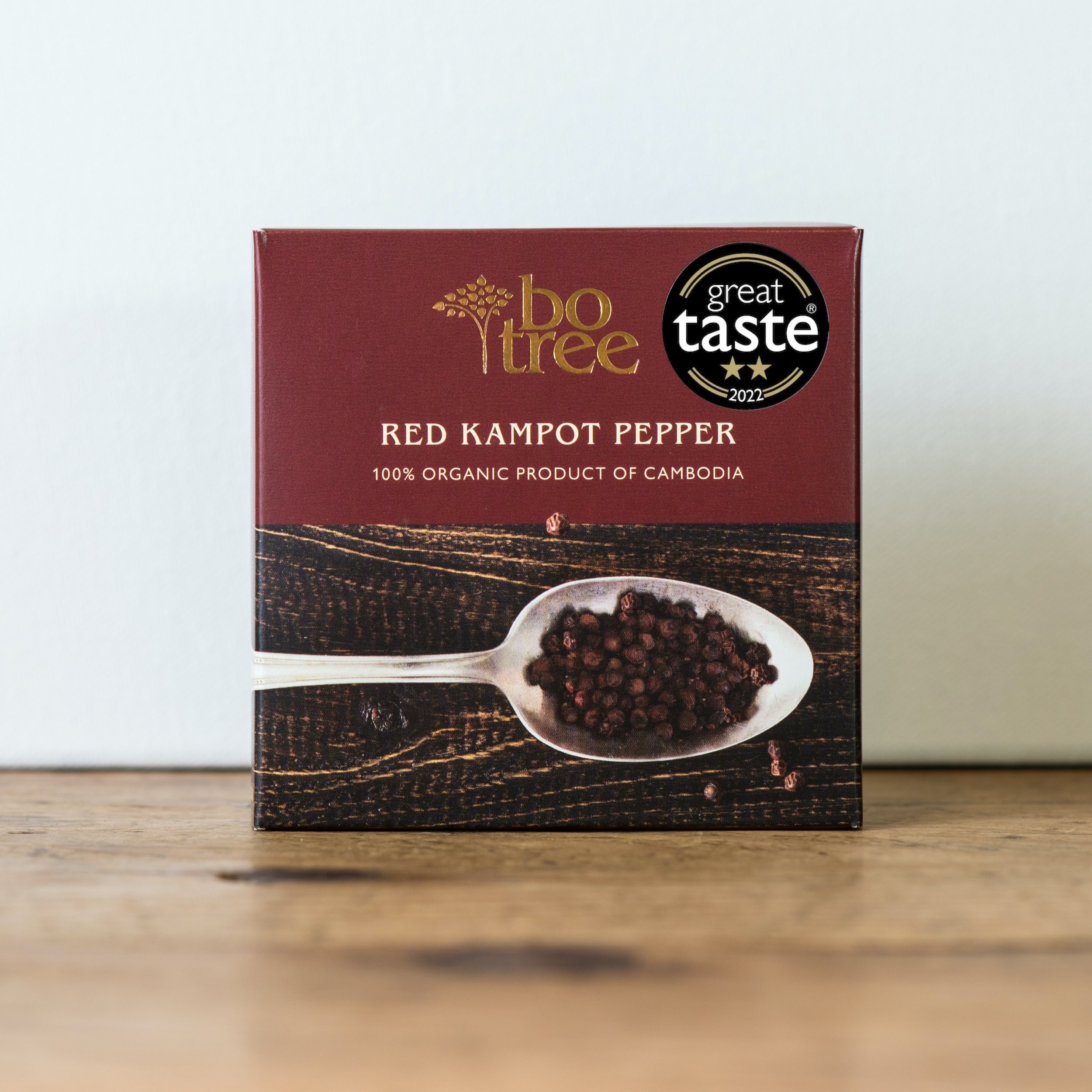
BOTREE IS A FAMILY OWNED SEASONING PRODUCER OF 100% ORGANIC, SINGLE-S0URCE KAMPOT PEPPER & exquisite Seasoning Products
We love tasting how seasoning perfection can transform food, and sharing that experience with people who love to cook and eat. Whilst professional chefs know the difference quality seasonings make in overall food flavours, we see a public ripe for this knowledge.
We are passionate purveyors of Kampot Pepper because we believe it’s the world’s best pepper, and the heritage is unlike any other. With records of regional pepper dating back to the 13th century, by the early 20th century the pepper industry was exporting over 8,000 tonnes of pepper, favoured in particular by French restaurants. But during the Khmer Rouge era, the century-old pepper industry was labeled a luxury crop and destroyed.
Today, a seasoning renaissance is underway, sustained by traditional farming wisdom passed down through generations. Buying Kampot Pepper supports Cambodia investing again in its finest produce and only crop export. We honour this legacy through our commitment to being stewards of the earth, ethical employers, and contributing members of the Kampot community.
Most of the workers on the farm are family members, though seasonally we employ people from the whole local community to assist at times of high activity - plucking the flowers from newly planted pepper vines and, of course, during the pepper harvest that normally takes place between March and May.
Bo Tree Farm is wholly owned by a Scottish-Cambodian family. We currently employ over 20 workers - many of whom are family members on the Khmer side, who receive free lodging and food as well as higher than average salaries for the sector. we send regular shipments to our family home in Scotland where it is sold widely across the UK.
Our pepper is vacuum packed before it leaves the farm ensuring that it arrives to you as fresh as the day it left us.
Kampot Pepper :
Shop Now

Kampot is renowned for the very high quality of its pepper where the best soil, climate and hydrology conditions converge to provide an ideal growing environment.
As a result, Kampot Pepper is the only pepper in the world to have attained Protected Geographic Indication (PGI), similar to Champagne, Cognac or Stilton Cheese. The PGI status was ratified by the European Union on 18 February 2016.
Originating in India, pepper (Piper nigrum L) is a vine that climbs up trees or poles planted in the ground reaching up to 10m tall. There are 2 types of pepper grown in Kampot - and on our farm - which qualify for the PGI status: Kamchay and Lampong, known locally as big leaf or small leaf pepper. The corns grow on a string, known as a “spike”, that grows up to around 10cm long, each producing up to 50 to 60 peppercorns per spike. As with most fruits, the corns turn red when ripe.
Black pepper is derived from the about to ripen, green berries, dried in the sun. The red pepper is produced from the red, ripe berries, and the white pepper is made from red peppercorns with the skins removed. Red and white corns are hard to produce and make up a small percentage of the pepper crop. Birds enjoy the taste of the ripe berries and are likely to get to them before we do, therefore we harvest the spikes when only the first half dozen or so berries have turned red.
The Taste of Heritage
CERTIFIED ORGANIC & PGI RATED THE CHAMPAGNE OF PEPPER
Kampot Pepper Promotion Association
As a member of the Kampot Pepper Promotion Associaton (KPPA) our farm is regularly inspected to ensure that the final product originates from the defined geographical area and comply with all the requirements of the Specifications both internal and external controls are measured and inspected.
The internal control to verify the compliance of all the operators with the specifications and is implemented by the KPPA Staff.
The KPPA’s inspectors have been trained by various external certification bodies and monitor quality improvements due to BoS and control system, especially on hygiene and environment aspects.
Protected Designations of Origin
A geographical indication designates and protects a product coming from a specific geographical area and which particular quality, reputation or other characteristics can be linked directly with this geographical origin.
Kampot Pepper is the first ever Protected Geographical Indication (PGI) from Cambodia to be registered, 'ម្រេចកំពត' (Mrech Kampot) / ‘Poivre de Kampot’ are pepper berries of the Kamchay and the Lampong varieties growing in southern Cambodia.
There are four different types of 'ម្រេចកំពត' / ‘Poivre de Kampot’ depending on the time of harvesting and the processing they receive afterwards: green, black, red and white pepper
Organic Guarantee System for Cambodia
To guide farmers, producers, traders and food processors as well as consumers, COrAA developed the “Standards for Organic Crop Production” and the “Standards for Chemical-Free Crop Production”.
These provide the basis for COrAA’s inspection and certification scheme (for the domestic market). Only farm products, which have been certified by COrAA, may be labeled “Organic “or “Chemical-free” respectively.
The certification allows consumers to appreciate the distinct quality and to be confident that the farmers have strictly followed the principles stated in the standards. As a result, the standards provide an instrument to offer clarity and to build up trust in chemical-free or organic products.
Seasoning Explained
There are two main times to think about seasoning – the beginning and the end. For slow cooked dishes it’s a good idea to get some salt and pepper in early so they can spread through the whole dish over time. For most other foods seasoning at the end is the best way to go.
Pepper Piper nigrum
Pepper is a source of piperine, (the main component in pepper ) which cause mild irritation and inflammation in the mouth when consumed. That inflammation leads to additional sensitivity of our taste receptors. Saltiness, acidity (i.e., sourness), and feelings of hot and cold are generally the most impacted by this inflammation; all of these sensations are enhanced.
Salt Sodium chloride
Salt is one of the five basic tastes (along with bitter, sweet, sour, and umami or savory). It enhances foods by essentially turning up the volume of their salty flavours. Salt can also dial down the taste of bitter foods by suppressing our perception of bitterness, and balance other tastes like sweet and sour (salt added to desserts or vinaigrettes, for example). Salt also unravels (or denatures) the tight spiral structure of proteins, making their flavors tastier and more aromatic.
Even the texture of salt enhances the taste of food. Flake salts like Maldon or ground Himalayan Rock Salt (our favourite) sprinkled over a green salad transmit crunchy bursts of saltiness that enhance the soft texture and mild flavors of lettuce leaves and other vegetables. And surprisingly, salt brings out aromas, too, because it helps release aroma molecules from food into the air. These stimulate our olfactory receptors, helping us to smell things.
So Pepper wakes up our taste buds and adds sensitivity to our taste receptors. Salt can then do its job of turning up the volume of salty food or turning down the volume of bitter tasting foods.
Kampot Pepper (the Worlds best Pepper) keeps your taste buds awake longer than any other Pepper, allowing you to enjoy the taste of food for longer.
And a big Bonus, your average peppercorn has very little flavour, Kampot Pepper reveals outstanding floral, eucalyptus and citrus flavours unlike any other pepper, further enhancing your food flavours.
Rick Stein on Black Pepper from Kampot, Cambodia
For the food connoisseur - Rick Stein's Far Eastern Odyssey
The odyssey begins in Cambodia - a country still recovering from the horrific regime of the Khmer Rouge. Nevertheless, tourists (and not just back-packing gap year students) are beginning to return to this land dotted with sugar palms, paddy fields and small villages.
Rick discovers the joys of freshly caught swimmer crabs cooked with the green peppercorns from Kampot, once the king of pepper. He learns how to cook the most famous dish in the country, Fish Amok, made with lemongrass and coconut and he samples Lok Lak, an extremely popular and delicious dish made with stir-fried strips of marinated beef.
The famous English seafood chef, Rick Stein, commented that “the pepper has a fabulous depth of flavour, aroma and pepperiness”.
Kampot Pepper Features on BBC Saturday Kitchen
Michel Roux delivers a fiery pepper steak for Davina McCall which she absolutely loves.
The recipe is available here and the iPlayer Episode is available here We recommend trying this with our mixed Kampot Pepper use Black, Red and White in equal quantities. Buy it Now
























